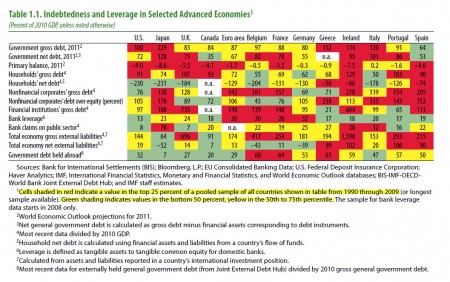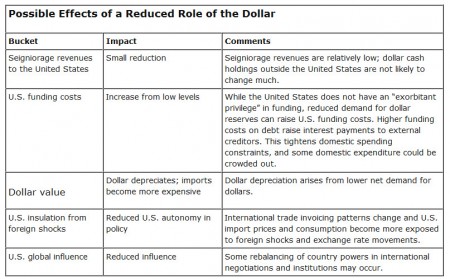Debt Snapshot
A snapshot of debt (government, household and corporate) of world’s advanced economies. For a hint of what’s likely to be the end of the game, read my previous post, “The moral breakdown“.
(click to enlarge; source: IMF)
Europe’s debt disease
The following graph was taken out from a recent report on Europe’s debt trajectory by GMO’s Rich Mattione. It pretty much summarizes the current dire situation in Europe.
Greece is not the only country in trouble. Italy is the real threat to the stability of Europe. If Italy falls, Europe falls.
Germany and France, the two largest economies in Europe, are relatively better positioned, but their government-debt-to-GDP ratios, 83% and 82%, respectively, will seriously constrain their ability to bail out the PIIGS (Portugal, Italy, Ireland, Greece and Spain). In contrast, Scandinavian countries enjoy the strongest position in all developed countries, with the debt-to-GDP ratio well below 50%.
[singlepic id=8 w=400 h=300 float=]
Summers still believes in “debt in, debt out”
Interview of Larry Summers. He assesses “double-dip” recession risk and advocates more government spending in order to generate enough demand. With 90% government debt-to-GDP ratio, Summers seems to ignore the fact that the US government is seriously constrained in engaging in further fiscal expansion.
Allan Meltzer, in his piece “Four Reasons Keynesians Keep Getting It Wrong“, offers a classic rebuttal:
Why is the economic response to increased government spending so different from the response predicted by Keynesian models? What is missing from the models that makes their forecasts so inaccurate? Those should be the questions asked by both proponents and opponents of more government spending. Allow me to suggest four major omissions from Keynesian models:
First, big increases in spending and government deficits raise the prospect of future tax increases. Many people understand that increased spending must be paid for sooner or later. Meanwhile, President Obama makes certain that many more will reach that conclusion by continuing to demand permanent tax increases. His demands are a deterrent for those who do most of the saving and investing. Concern over future tax rates is one of the main reasons for heightened uncertainty and reduced confidence. Potential investors hold cash and wait.
Second, most of the government spending programs redistribute income from workers to the unemployed. This, Keynesians argue, increases the welfare of many hurt by the recession. What their models ignore, however, is the reduced productivity that follows a shift of resources toward redistribution and away from productive investment. Keynesian theory argues that each dollar of government spending has a larger effect on output than a dollar of tax reduction. But in reality the reverse has proven true. Permanent tax reduction generates more expansion than increased government spending of the same dollars. I believe that the resulting difference in productivity is a main reason for the difference in results.
Third, Keynesian models totally ignore the negative effects of the stream of costly new regulations that pour out of the Obama bureaucracy. Who can guess the size of the cost increases required by these programs? ObamaCare is not the only source of this uncertainty, though it makes a large contribution. We also have an excessively eager group of environmental regulators, protectors of labor unions, and financial regulators. Their decisions raise future costs and increase uncertainty. How can a corporate staff hope to estimate future return on new investment when tax rates and costs are unknowable? Holding cash and waiting for less uncertainty is the principal response. Thus, the recession drags on.
Fourth, U.S. fiscal and monetary policies are mainly directed at getting a near-term result. The estimated cost of new jobs in President Obama’s latest jobs bill is at least $200,000 per job, based on administration estimates of the number of jobs and their cost. How can that appeal to the taxpayers who will pay those costs? Once the subsidies end, the jobs disappear—but the bonds that financed them remain and must be serviced. These medium and long-term effects are ignored in Keynesian models. Perhaps that’s why estimates of the additional spending generated by Keynesian stimulus—the “multiplier effect”—have failed to live up to expectations.
Understand the new European plan
update 1 (Oct. 30. 2011)
Ken Rogoff comments on the new plan: This is not the end; Euro is half-baked.
Steve Jobs Stories
Walter Isaacson shares his experience writing Jobs’ biography, a lot of interesting secret stories – what to make an innovative man who transformed the whole technology industry.
Part 1
Part 2
No hard landing for China, or is it?
Here I included two pieces to address the question whether China will have “hard landing” or not. Hard landing is a fancy phrase to describe the situation when government tries control high inflation, it slams on the brake to dramatically slow down the economy, often leading to the outright recession. In China’s case, a hard landing, along with rising interest rate, may trigger the burst of the housing bubble.
The first piece is by Stephen Roach, former Chief economist, and Asian Chairman at Morgan Stanley, now a professor at Yale University. The second piece is a recent interview of Jim O’Neill, Chairman of Goldman Sachs’ Asset Management (or GSAM). Both are leading authorities on Chinese economy.
Roach took a big-picture view, and argues China is more likely to have a soft landing, not hard landing.
China’s economy is slowing. This is no surprise for an export-led economy dependent on faltering global demand. But China’s looming slowdown is likely to be both manageable and welcome. Fears of a hard landing are overblown.
To be sure, the economic data have softened. Purchasing managers’ indices are now threatening the “50” threshold, which has long been associated with the break-even point between expansion and contraction. Similar downtrends are evident in a broad array of leading indicators, ranging from consumer expectations, money supply, and the stock market, to steel production, industrial product sales, and newly started construction.
But this is not 2008. Back then, global commerce was collapsing, presaging a 10.7% drop in the volume of world trade in 2009 – the sharpest annual contraction since the 1930s. In response, China’s export performance swung from 26% annual growth in July 2008 to a 27% contraction by February 2009. Sequential GDP growth slowed to a low single-digit pace – a virtual standstill by Chinese standards. And more than 20 million migrant workers reportedly lost their jobs in export-led Guangdong province. By late 2008, China was in the throes of the functional equivalent of a full-blown recession.
Thanks to a massive fiscal stimulus, China veered away from the abyss in early 2009. But it paid a price for this bank-funded investment boom. Local governments’ indebtedness soared, and fixed investment surged toward an unprecedented 50% of GDP. Fears surfaced of another banking crisis, the imminent collapse of a monstrous property bubble, and runaway inflation. Add a wrenching European crisis to the equation, and a replay of 2008 no longer seemed far-fetched.
While there is a kernel of truth to each of these China-specific concerns, they do not by themselves imply a hard landing. Nonperforming loans will undoubtedly increase in response to the banking sector’s exposure to some $1.7 trillion of local-government debt, much of which was incurred during the stimulus of 2008-2009. But the feared deterioration in loan quality is exaggerated.
Jim O’Neill Interview (courtesy of CNBC): He thinks the chance for a hand landing is very slim.
Update 1 (Oct. 30, 2011):
Jim Chanos share his recent view on China – he continues to short China’s banking sector and real estate developers. He believes Chinese banking system just started to have cracks; there is more to come.





